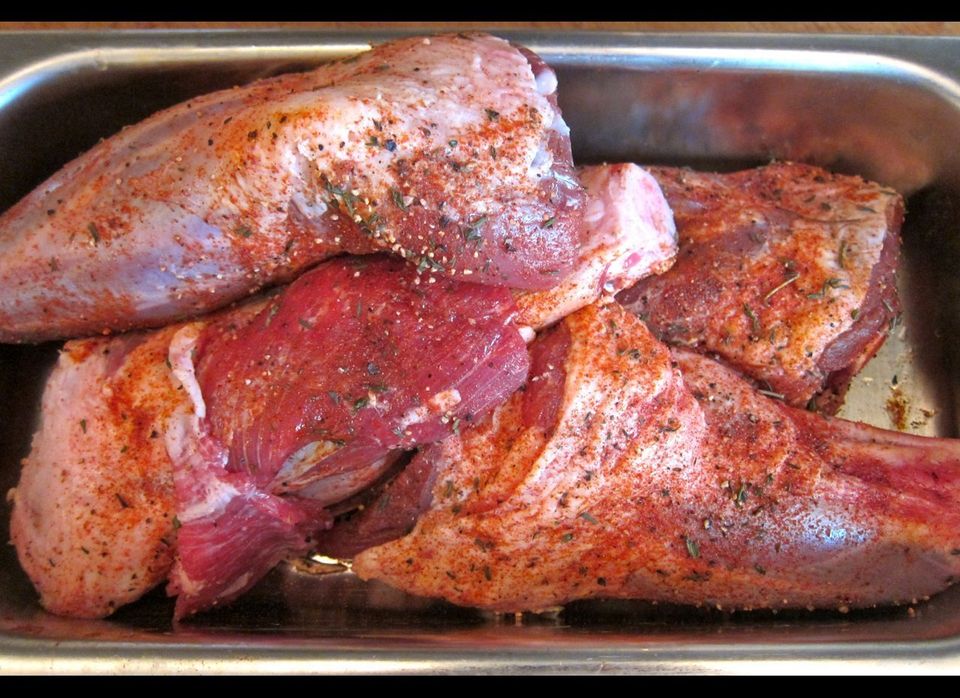It surprised me to read on these very pages that there are celery-haters out there. Perhaps, as with cilantro (coriander leaf), there's a genetic switch that turns some people off this excellent vegetable, though I am guessing it's just a matter of preference.
Mind you, it is a plant best used with some care, because it can take over a dish: I always think of a vegetable stock I once made with too much celery - you could barely taste any other ingredient. The other day, though, I thought I'd let it run riot over a pot of braised lamb shanks, the plan being to build a foundation of celery flavor to echo the diced celery root (celeriac) that was going to finish the dish.
I did this in two ways. First, where I might have used less than a single stalk of celery in the usual leek-carrot-onion-celery-garlic mixture flavoring the braise, I used a full five stalks (one more than you'll see in the photo). Secondly, I added a teaspoonful of celery seed during the cooking, as you will see.
The day before I'd even thought about flavorings, though, I rubbed salt, pepper, thyme and paprika into four meaty lamb shanks and refrigerated them overnight. (When I hit upon the three-celery approach I had second thoughts about the paprika, but it worked out well.) Next morning, I heated the oven to just under 350 degrees F. Then I took a 12-inch braising pan and browned the shanks in olive oil - slowly: it took a good 20 minutes over medium-low heat - and chopped two smallish leeks (washed), an onion, a peeled carrot, some parsley stems and those four stalks of celery, and I lightly smashed two cloves of garlic and discarded the skins. When the lamb was nicely browned, I removed it from the pan and added the vegetables, well salted, to soften and just begin to brown. At some point along the way I tossed in some thyme and a teaspoon of celery seed, whose aromas immediately filled the kitchen.
I returned the lamb to the pan along with a third of a bunch of parsley and a cup of white wine and raised the heat to reduce the wine by about half (the percentage of reduction isn't crucial: just make sure it doesn't smell harsh). I added a cup and a half of stock: surprisingly, there was a little lamb stock in the freezer, which I eked out with chicken stock, but all chicken or a light veal or beef stock would work fine. Vegetable stock would be okay too, but not ideal here because there's already a lot of vegetable action under way in the pot.
I laid a pierced circle of parchment paper on top of the meat (which was not totally submerged in liquid), put the lid on slightly ajar to prevent the temperature rising too high within the pan, and put the pan into the oven with a timer set for two and a half hours. After an hour, I turned the shanks in the cooking liquid and had a sniff: Lamb was the dominant aroma (whew!), but celery came in a close second, thanks in good part to the celery seed. The liquid was getting a trifle skimpy, and I wanted a reasonable amount of sauce to be generated (enough to cook the celery root later), so I added a cup of hot water before returning the pan to the oven.
After another 90 minutes, another turn and some more water, the lamb was very tender and I left it in the pan to cool a little before removing the shanks to a plate and straining the liquid into a container, pressing hard on the vegetables to extract flavor, liquid and even some of the pulp to give the sauce extra body. I discarded the spent vegetable debris.
To serve (which was the next day, though it didn't need to be), I removed the fat that had congealed on the sauce's surface and heated the lamb and sauce. I peeled two small celery roots, cut them into into 3/8-inch dice and cooked them in a separate pan with a smidgeon of butter, a sprinkling of celery seed and a bit of the sauce until lightly glazed and barely tender before adding them to the lamb and remaining sauce. Once seasoning had been adjusted, the dish worked as I'd hoped it would: The background flavor/aroma of celery stalk and seed, while not overwhelming, reinforced the freshly cooked celery root and made it somehow more prominent.
The dish, of course, could have been accompanied by still more celery, either celery root pureed with potato or, more interesting, braised celery stalk diced and mixed into crushed potatoes and brightened with lemon juice. But that would have been overkill, so I made a pot of polenta instead. Because - who knows? - maybe there's a celery threshold beyond which anyone becomes a hater.
